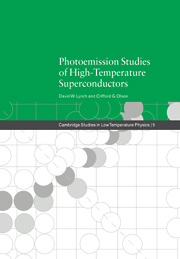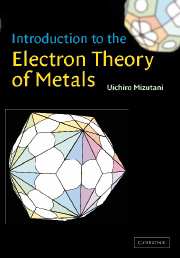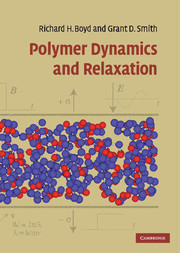Refine search
Actions for selected content:
106100 results in Materials Science

Polarons and Bipolarons in High-Tc Superconductors and Related Materials
-
- Published online:
- 24 November 2009
- Print publication:
- 07 September 1995

Photoemission Studies of High-Temperature Superconductors
-
- Published online:
- 23 November 2009
- Print publication:
- 28 May 1999

Molecular Organic Materials
- From Molecules to Crystalline Solids
-
- Published online:
- 23 November 2009
- Print publication:
- 27 April 2006

Introduction to the Electron Theory of Metals
-
- Published online:
- 20 November 2009
- Print publication:
- 14 June 2001

Polymer Dynamics and Relaxation
-
- Published online:
- 10 November 2009
- Print publication:
- 13 September 2007
APPENDIX II - Stereographic Representation of Orientations
-
- Book:
- Mechanical Behavior of Materials
- Published online:
- 05 June 2012
- Print publication:
- 09 November 2009, pp 412-414
-
- Chapter
- Export citation
13 - Ductility and Fracture
-
- Book:
- Mechanical Behavior of Materials
- Published online:
- 05 June 2012
- Print publication:
- 09 November 2009, pp 208-224
-
- Chapter
- Export citation
4 - Strain Hardening of Metals
-
- Book:
- Mechanical Behavior of Materials
- Published online:
- 05 June 2012
- Print publication:
- 09 November 2009, pp 65-73
-
- Chapter
- Export citation
1 - Stress and Strain
-
- Book:
- Mechanical Behavior of Materials
- Published online:
- 05 June 2012
- Print publication:
- 09 November 2009, pp 1-19
-
- Chapter
- Export citation
16 - Creep and Stress Rupture
-
- Book:
- Mechanical Behavior of Materials
- Published online:
- 05 June 2012
- Print publication:
- 09 November 2009, pp 259-274
-
- Chapter
- Export citation
6 - Strain Rate and Temperature Dependence of Flow Stress
-
- Book:
- Mechanical Behavior of Materials
- Published online:
- 05 June 2012
- Print publication:
- 09 November 2009, pp 92-112
-
- Chapter
- Export citation
Contents
-
- Book:
- Mechanical Behavior of Materials
- Published online:
- 05 June 2012
- Print publication:
- 09 November 2009, pp v-xii
-
- Chapter
- Export citation
3 - Mechanical Testing
-
- Book:
- Mechanical Behavior of Materials
- Published online:
- 05 June 2012
- Print publication:
- 09 November 2009, pp 36-64
-
- Chapter
- Export citation
2 - Elasticity
-
- Book:
- Mechanical Behavior of Materials
- Published online:
- 05 June 2012
- Print publication:
- 09 November 2009, pp 20-35
-
- Chapter
- Export citation
14 - Fracture Mechanics
-
- Book:
- Mechanical Behavior of Materials
- Published online:
- 05 June 2012
- Print publication:
- 09 November 2009, pp 225-243
-
- Chapter
- Export citation
17 - Fatigue
-
- Book:
- Mechanical Behavior of Materials
- Published online:
- 05 June 2012
- Print publication:
- 09 November 2009, pp 275-301
-
- Chapter
- Export citation
APPENDIX I - Miller Indices
-
- Book:
- Mechanical Behavior of Materials
- Published online:
- 05 June 2012
- Print publication:
- 09 November 2009, pp 407-411
-
- Chapter
- Export citation
11 - Hardening Mechanisms in Metals
-
- Book:
- Mechanical Behavior of Materials
- Published online:
- 05 June 2012
- Print publication:
- 09 November 2009, pp 184-198
-
- Chapter
- Export citation
21 - Composites
-
- Book:
- Mechanical Behavior of Materials
- Published online:
- 05 June 2012
- Print publication:
- 09 November 2009, pp 363-384
-
- Chapter
- Export citation
10 - Mechanical Twinning and Martenitic Shear
-
- Book:
- Mechanical Behavior of Materials
- Published online:
- 05 June 2012
- Print publication:
- 09 November 2009, pp 166-183
-
- Chapter
- Export citation
